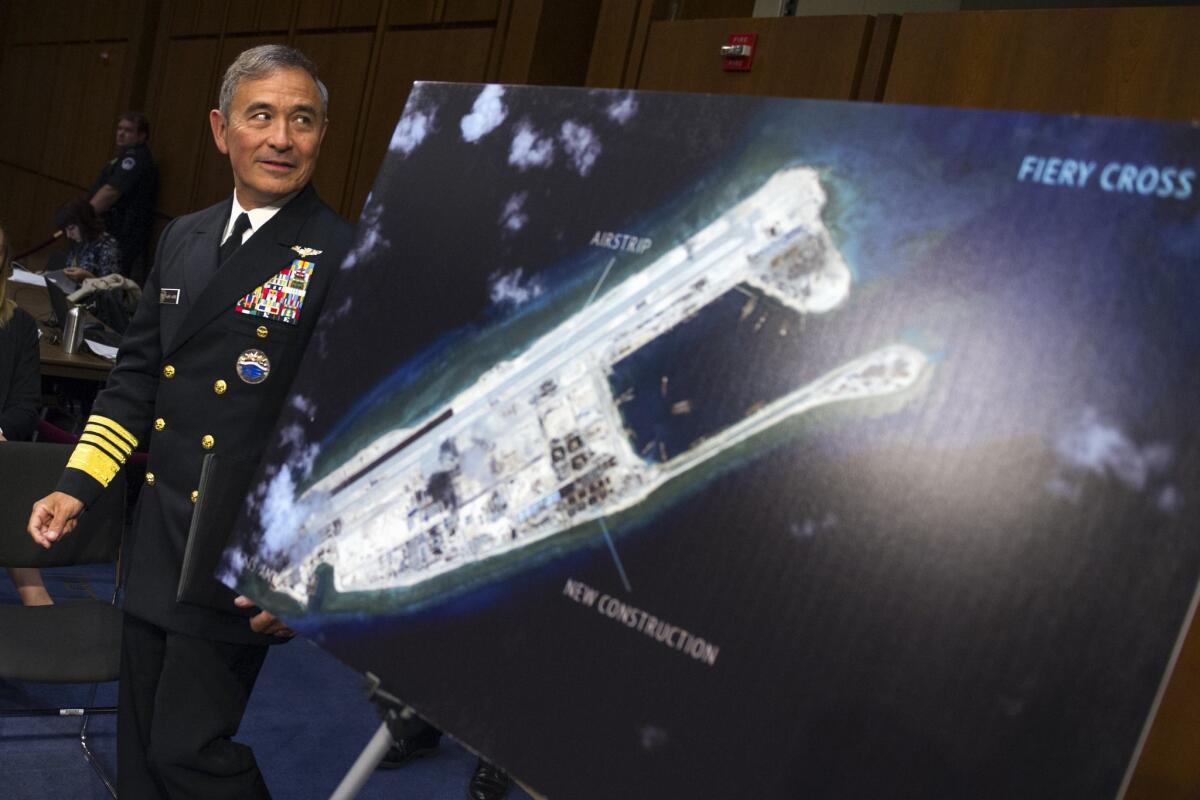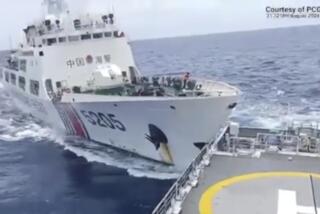China, angered over warship patrol near artificial islands, warns U.S. not to ‘create trouble’

During a Sept. 17 congressional hearing, Navy Adm. Harry B. Harris Jr. walks past a photograph showing an island that China is building on the Fiery Cross Reef in the South China Sea.
- Share via
Reporting from Beijing — China reacted angrily Tuesday after a U.S. warship sailed within 12 miles of artificial islands it is constructing in the South China Sea, calling the move a provocation and warning Washington “not to act blindly or create trouble out of nothing.”
Foreign Ministry spokesman Lu Kang said the U.S. decision to send the Lassen, a guided-missile destroyer, threatened “China’s sovereignty and security interests.”
The U.S. acknowledged that a Navy destroyer had sailed near the islands, in what was meant as a rebuff of Beijing’s territorial and maritime claims in the disputed waters.
NEWSLETTER: Get the day’s top headlines from Times Editor Davan Maharaj >>
The White House approved the patrol near Subi and Mischief reefs in the Spratly Islands to assert the U.S. position that they lie in international waters where ships from all countries are free to travel, said a senior U.S. defense official, who asked not to be identified to discuss military operations.
China claims sovereignty over a large swath of the South China Sea and has been dredging sand and building facilities, including runways and ports, on various islets and reefs. But other countries, including the Philippines, also have asserted claims to some of the specks of land in the region.
U.S. officials are concerned that China eventually wants to use the islets for military purposes and is ultimately seeking to push U.S. forces out of what it regards as its own backyard.
American authorities have been suggesting for months that they might send a naval vessel through the area near the newly reclaimed islands to illustrate Washington’s commitment to freedom of navigation in the area. But Lu said the American move does not belong “to the so-called exercise of freedom of navigation.”
The U.S. has said it does not take sides regarding the competing claims to islands and reefs in the area but has urged that the disputes be settled through international protocols.
Japan expressed support Tuesday for the U.S. move, with Chief Cabinet Secretary Yoshihed Suga saying China’s “unilateral conduct to change the status quo” in the South China Sea was fueling tension in the region.
Euan Graham, director of the International Security Program at the Lowy Institute in Australia, said in a commentary Tuesday that the U.S. operation is unlikely to be a one-off and “will probably usher in a sustained U.S. naval and air presence in the weeks ahead” in the area.
What further steps, if any, China may take remains to be seen. Graham said that “by prevaricating so publicly and for so long the U.S. unnecessarily put its credibility on the line and has also made it harder for China to calibrate its reaction.”
“Ultimately,” he added, “it may take a crisis for the U.S.-China relationship to reach a stable equilibrium.”
China’s Foreign Ministry said authorities monitored and warned the Lassen as it entered what China claims as a 12-mile territorial limit around the reefs in the Spratly archipelago, a group of reefs, islets and atolls where the Philippines has competing claims.
“The actions of the U.S. warship have threatened China’s sovereignty and security interests, jeopardized the safety of personnel and facilities on the reefs, and damaged regional peace and stability,” the ministry said on its website.
“The Chinese side expresses its strong dissatisfaction and resolute opposition,” the statement said.
Chinese Vice Foreign Minister Zhang Yesui summoned U.S. Ambassador to China Max Baucus on Tuesday, lodging “serious representations” and expressing “strong discontent” over the patrol, the state-run New China News Agency said.
The move risks provoking a confrontation with China’s military and could raise diplomatic tensions with Beijing weeks before President Obama and Chinese President Xi Jinping, who met last month in Washington, are expected to attend four major summit meetings in Asia.
The patrol by the Lassen marked the first time a Navy warship has sailed within the territorial limit that China has claimed for half a dozen reefs and shoals that it has been building up into islands. U.S. surveillance aircraft may also breach the boundary.
Because of uncertainty about how China would respond, the Lassen and any U.S. military aircraft to join the operation were to be on a heightened state of alert, the U.S. defense official said.
U.S. officials emphasize that the man-made islands do not constitute sovereign territory under international law and cannot be used to assert claims to territorial waters.
A Pentagon spokesman, Navy Cmdr. Bill Urban, declined to comment on the specifics of the operation, but said “the United States is conducting routine operations in the South China Sea in accordance with international law.”
More than $5 trillion worth of world trade passes through the South China Sea every year, making it one of the world’s busiest waterways.

A Chinese navy dispatcher demanded eight times Wednesday that a U.S. Air Force P8-A Poseidon surveillance aircraft leave the area as it flew over Fiery Cross Reef, where China has conducted extensive reclamation work on what it claims as sovere
“There are billions of dollars of commerce that flow through that region of the world every year,” White House Press Secretary Josh Earnest said Monday. “Ensuring the free flow of this commerce and that freedom of navigation of those vessels is protected is critically important to the global economy.”
Vietnam and Taiwan, as well as the Philippines and other countries, claim parts of the South China Sea, which has significant oil and gas deposits, and have undertaken their own dredging projects on reefs and shoals over the years.
The U.S. has long refused to take a position on the sometimes overlapping claims. But the White House has challenged China’s claim of virtually the entire sea as its territory. Beijing has rebuffed calls for international mediation to settle the territorial and maritime disputes.
Since the U.S. began signaling this month that it was planning to send a warship near the islands, some Chinese officials have warned that its armed forces would defend the territorial claims, while others have said that they would merely monitor U.S. vessels and aircraft.
It’s rare for the Pentagon to telegraph in advance such a sensitive military move. The Navy conducts dozens of so-called freedom of navigation operations around the world every year, sending ships into disputed maritime areas, usually with no notice, to underscore U.S. claims that they are international waters.
The Lassen spent four weeks in the South China Sea recently and was trailed at times by Chinese navy vessels. But the U.S. warship had not come within 12 miles of any of the islands being constructed by China, officials said.
Dredging at Subi and Mischief reefs, once little more than coral outcroppings that were mostly submerged at high tide, has dramatically expanded them over the last two years, according to an analysis of satellite pictures by the Center for Strategic and International Studies, a Washington think tank.
Mischief Reef is now estimated to be 6.5 million square yards in area, and Subi is estimated at 4.7 million square yards. But neither has progressed as much as Fiery Cross Reef, where China is building a 10,000-foot runway potentially usable by military planes.
By choosing to patrol near less built-up islands, the U.S. may be hoping to avoid a confrontation with China.
But Beijing has also had time to position naval and coast guard forces in the vicinity so that it can shadow or potentially harass U.S. ships that cross the 12-mile line.
The last time the U.S. patrolled near South China Sea island areas claimed by China was in 2012, before the reclamation projects began, officials said.
In May, a U.S. Navy P-8A Poseidon surveillance aircraft flew near Fiery Cross Reef but stayed outside the 12-mile limit. Even so, a Chinese military dispatcher demanded repeatedly that the airplane leave the area, warning that it was approaching a “military alert zone.”
The same month, a U.S. warship sailed through the Spratlys but also remained more than 12 miles from China’s man-made islands. It was tailed but not interfered with by a Chinese navy vessel.
Makinen reported from Beijing and Cloud from Washington. Times staff writer W.J. Hennigan in Washington contributed to this report.
Twitter: @davidcloudLAT @juliemaklat
ALSO
Kerry’s mosque-cam idea -- breakthrough or ‘trap’?
How Mexico escaped the worst of Hurricane Patricia
U.S.-Cuba thaw lets a top Homeland Security official return to his birthplace
More to Read
Sign up for Essential California
The most important California stories and recommendations in your inbox every morning.
You may occasionally receive promotional content from the Los Angeles Times.












